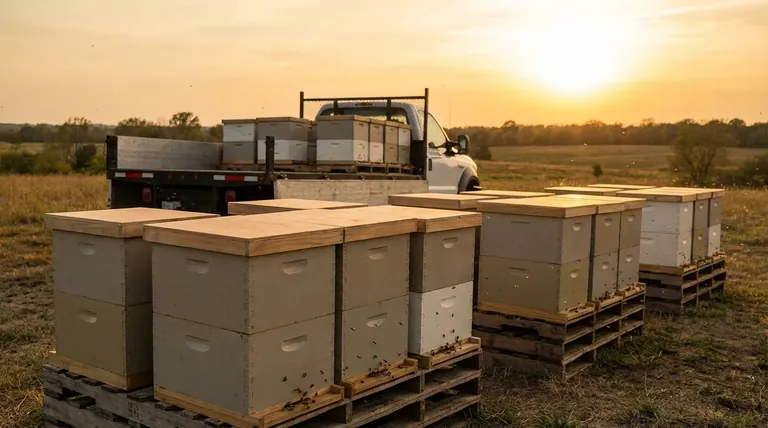At its core, a migratory lid is a minimalist hive cover designed for function over form. It is a simple, flat wooden cover that sits flush with the sides of the hive body, prioritizing ease of handling, low cost, and a space-saving profile. Its primary advantages are directly tied to the needs of commercial beekeepers who must frequently move large numbers of colonies for pollination or honey production.
The choice between a migratory lid and a traditional telescoping cover is not about which is "better," but which is suited for your operational goal. Migratory lids prioritize efficiency and mobility for commercial operations, while telescoping covers prioritize maximum protection for stationary hives.

The Anatomy of a Migratory Lid
A Focus on Utilitarian Design
The migratory lid is the definition of simplicity. It is typically a single flat piece of wood, often with two wooden rails on either end that serve as handles and add rigidity.
This design stands in contrast to the standard two-piece telescoping cover and inner cover system found on most hobbyist hives, which is heavier and more complex.
The Critical Flush-Fit Profile
The defining feature of a migratory lid is that it does not overhang the sides of the hive box. It fits flush with the hive body's dimensions.
This single design choice is the source of its primary advantage: allowing hives to be packed tightly against one another.
Material and Cost
These lids are inexpensive and often easy for beekeepers to construct themselves. The low cost is a significant factor for commercial apiaries managing hundreds or thousands of colonies, where equipment costs can be substantial.
The Key Advantages for Commercial Beekeeping
Unmatched Spatial Efficiency
Because migratory lids have no side overhang, hives can be pushed tightly together on a pallet. This eliminates wasted space, allowing a beekeeper to load the maximum number of colonies—often four per pallet—onto a truck.
This efficiency is crucial for commercial pollination services, where moving thousands of hives quickly and economically is paramount.
Streamlined Handling and Weight
The lightweight, simple construction makes the migratory lid fast and easy to remove for hive inspections. This saves valuable time and labor when working through a large apiary.
Lower Operational Costs
For a beekeeper with a thousand hives, the cost difference between migratory lids and more expensive telescoping covers is significant. Their simple design also means they are easier and cheaper to repair or replace.
Understanding the Trade-offs: Protection vs. Efficiency
Reduced Weather Protection
The greatest drawback of the migratory lid is its reduced protection from the elements. It provides less insulation from both extreme heat and cold compared to the telescoping cover, which creates a dead air space with its inner cover.
Vulnerability to Moisture
A telescoping cover overhangs the hive, directing rain away from the hive joints. The flush-fitting migratory lid does not offer this protection, making the hive more susceptible to water seeping in during heavy rain.
This makes it a poor choice for regions with significant rainfall, as moisture is a major stressor for a honey bee colony.
Limited Ventilation Control
The traditional inner cover (used with a telescoping lid) has a notch that provides upper ventilation. The migratory lid sits directly on the top hive box, offering no such built-in feature and limiting options for controlling airflow.
Making the Right Choice for Your Apiary
To select the right cover, you must align your equipment with the primary purpose and climate of your beekeeping operation.
- If your primary focus is commercial pollination or large-scale honey production: Choose the migratory lid for its efficiency in transport, handling, and cost.
- If your primary focus is backyard or hobby beekeeping in a stationary location: Opt for the telescoping outer cover for its superior weather protection and insulation.
- If you live in a consistently warm and dry climate: The migratory lid can be a viable and cost-effective option even for stationary hives.
- If you live in a region with cold winters or significant rainfall: The telescoping cover is almost always the more responsible choice to ensure colony health and survival.
Ultimately, understanding your hive's operational context is the key to selecting the proper equipment for its success.
Summary Table:
| Feature | Migratory Lid | Traditional Telescoping Cover |
|---|---|---|
| Primary Use | Commercial, migratory operations | Stationary, hobbyist hives |
| Design | Simple, flat, flush-fit | Complex, two-piece with overhang |
| Key Advantage | Space efficiency for transport | Superior weather protection |
| Cost | Lower | Higher |
| Ideal For | Pollination services, large-scale honey production | Backyard beekeeping, harsh climates |
Equip your commercial apiary for maximum efficiency and profitability.
At HONESTBEE, we specialize in supplying high-quality, durable migratory lids and other essential beekeeping supplies to commercial apiaries and distributors. Our wholesale-focused operations are designed to meet the demanding needs of large-scale beekeeping, helping you reduce costs and streamline your workflow.
Contact HONESTBEE today to discuss your equipment needs and discover how our products can support the success of your operation.
Visual Guide

Related Products
- Inner Beehive Cover for Beekeeping Bee Hive Inner Cover
- Professional Insulated Winter Hive Wrap for Beekeeping
- Stainless Steel Beekeeping Honey Extractor Lid
- Long Langstroth Style Horizontal Top Bar Hive for Wholesale
- Professional Engraved Round Hive Number Tags for Beekeeping
People Also Ask
- What is the role of the inner cover in a beehive? Essential Climate Control for Hive Health
- What is the purpose of the inner cover in a beehive? A Key to Hive Health & Easy Management
- What are the advantages of using an inner cover in a beehive? Key Benefits for Hive Health & Beekeeper Efficiency
- What is the function of the center hole in the inner cover? Master Hive Ventilation and Feeding
- What is the recommended orientation for the rim of an inner cover? Master Hive Ventilation and Insulation



















